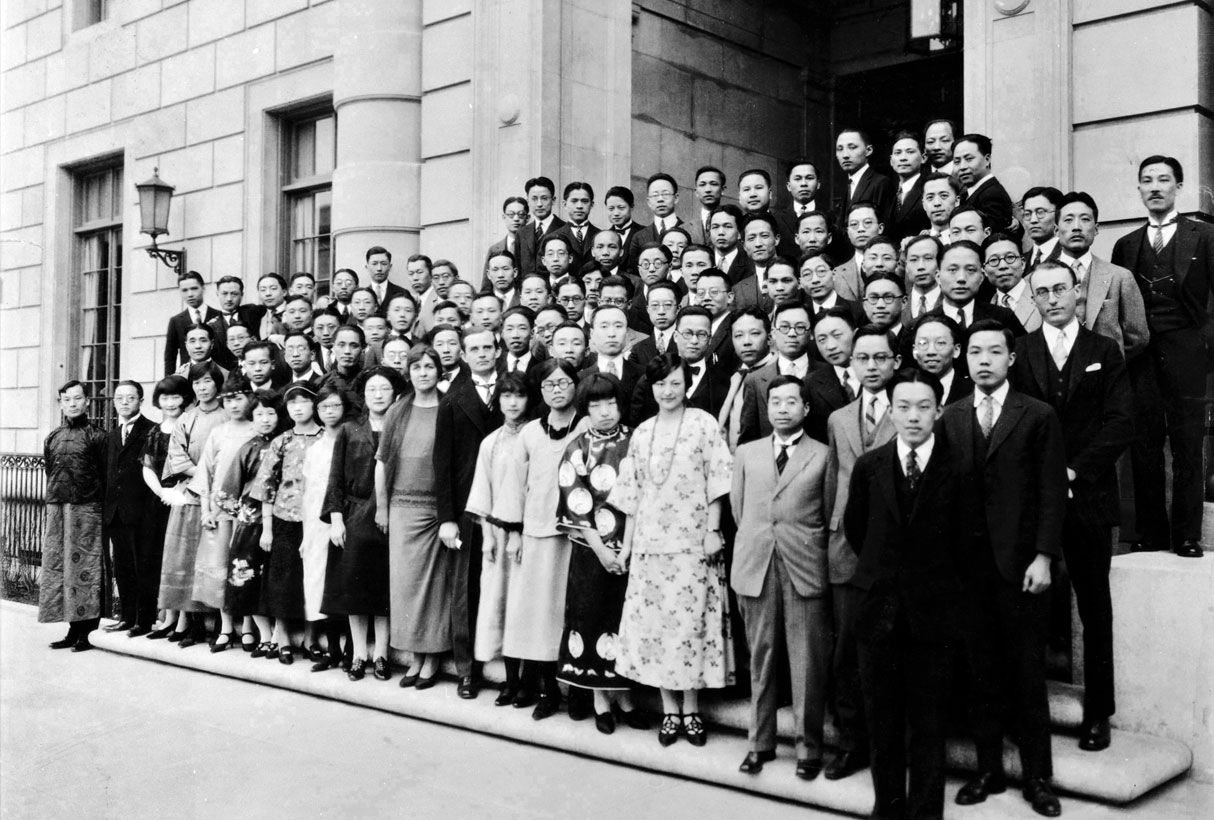
From the Archives: Early Chinese Residents
When the Donald L. Cuneo Hall of History opened last October, resident Peng Guan – a cellist studying at Manhattan School of Music – took note of photo of a large group of Chinese residents pictured with Harry and Florence Edmonds on the front steps of International House in 1925.
That, and the origin story of Edmonds and the lonely Chinese student, sparked the curiosity of Peng and some of her fellow residents, including Xiaoxing Gou, Paolo Sun, Naifei Qiang, Meiru Chen, Lexuan Li.
“Chinese scholars and academics’ exchange of culture and knowledge are no less significant than other communities,” wrote Peng. “Many contributed to peace and prosperity in the US and the world, and we should never forget those contributions.”
With that in mind, Peng asked if she and some of her team could access information about past Chinese residents in the I-House Archives. They poured over yearbooks and photo directories dating back to 1925, and then proceeded to conduct research on a number of those residents to learn what contributions many made after leaving the House. They made a number of fascinating discoveries.
The first was Han-Jun Lam ’35 (1912–1945), a sociologist born in Canton, China, who studied in the USA and graduated from North Carolina College for Women in 1933. She received a scholarship to continue her studies at the New York School of Social Work, and while living at I-House then was involved with the local Chinese community in New York. Lam returned to China in 1936, intending to study medicine in Peking, but the outbreak of war with Japan thwarted her ambitions. She instead went to Hong Kong, where she began working with the thousands of wartime refugees migrating to the already overcrowded city and worked for the Chinese Red Cross Foreign Auxiliary and the Chinese Defense League. Widely admired among the Chinese and British citizens, her health declined due to poor working conditions and exhaustion in wartime Hong Kong, where she died in November, 1945.
Hou Debang ’37 (1890-1974) was a scientist and chemical engineer well known for his discovery which improved the Solvay process for producing sodium carbonate. Born in the Taijiang District of Fuzhou, Hou was one of a group of scholars sent to study in the USA, where he obtained his Master’s Degree in chemical engineering from MIT in 1917, and his PhD from Columbia University in 1921. He wrote Manufacture of Soda, with Special Reference to the Ammonia Process (1933), an influential work in which he summarized his successful manufacturing of soda from a theoretical standpoint. Hou was a member of I-House in 1935-37. During World War II, he directed the early stages of a novel dual soda-manufacturing method that carries his name: Hou’s Process. In 1950, he served as a consultant in the Ministry of Heavy Industry, and in 1959 was appointed deputy minister of the Ministry of Chemical Industry. He died in 1974.
The group’s earliest find was of Li Peien ’39 (1889-?), a member of the Intercollegiate Cosmopolitan Club in 1920-22 while pursuing his MBA from New York University, who later returned New York and was a member of I-House in 1938-39 while pursuing his PhD at Columbia.
Li Peien (English name Baen E. Lee) came from an impoverished family in Hangzhou, and attended Yuying Academy, which had been established by the American Presbyterian Church in 1904. After his higher education in the United States, he returned to China as the English Editor of the Shanghai Commercial Press. He was invited to serve on the board of directors of Yuying Academy, later renamed Zhejiang University, and became its president in 1931. In the years that followed, under Li Peien’s leadership, the university established departments in science, commerce and architecture. In 1940, after his second stint in the USA, he created colleges of literature, business and engineering, and established twelve additional departments. He helped revitalize the school following damage sustained during World War II, and stepped down as president in May, 1949. The university was restructured in 1962, and remains a historic site, but further information about Li Peien is undocumented.
Li Peien’s second residency at I-House coincided with that of another Chinese student, Bangnee Alfred Liu ’40 (1901-?), who arrived at the House in the fall of 1938 to pursue his PhD in Measurement & Statistics at Teachers College. A native of Shanghai, Liu went on to serve as Research Associate at the China Institute in America, and as Senior Statistician and Chief of the Statistical Division of the newly formed United Nations in the late 1940s. His doctoral thesis, “Educational Research in Major American Cities” was published by Columbia University Press in 1945 and remains in circulation.
Peng Guan, a 2022 Davis Projects for Peace awardee, presented her group’s findings to the I-House Archives earlier this year, and the House is grateful to have this additional research as part of the permanent record.